www.stormx.com/agriculture Long-term variations in ocean circulations produce pronounced patterns of sea surface temperature (SST) anomalies that directly impact weather and climate. The most influential long-term oceanic cycle is the Pacific Decadal Oscillation (PDO), a large-scale phenomenon in the North Pacific that produces inter-decadal oscillations of cool and warm SST anomalies, with each phase typically lasting 20 to 30 years. During the cool (negative) phase of the PDO, a large horseshoe-shaped area of cooler than average SST extends from the central equatorial tropics northeastward to the Mexican and U.S. coastlines, then northward along the Canadian and Alaskan coastlines. During the warm (positive) phase the pattern is reversed with warm SSTs replacing the cool SSTs. The Atlantic Ocean experiences a similar oscillation known as the
Atlantic Multidecadal Oscillation (AMO) which has profound impacts on the number and intensity of Atlantic hurricanes as well as
Arctic sea ice extent.
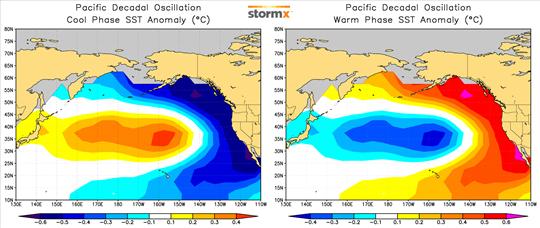
© StormX
After a period of intense cooling in the 1950s, 1960s, and 1970s, the PDO returned to the positive phase during the late 1970s and remained generally positive through the late 1990s. Since 1999, a transition into the cool phase has been underway, and during 2008 the transition was completed as recent observations of the coastal waters have been among the coolest in the past 109 years.
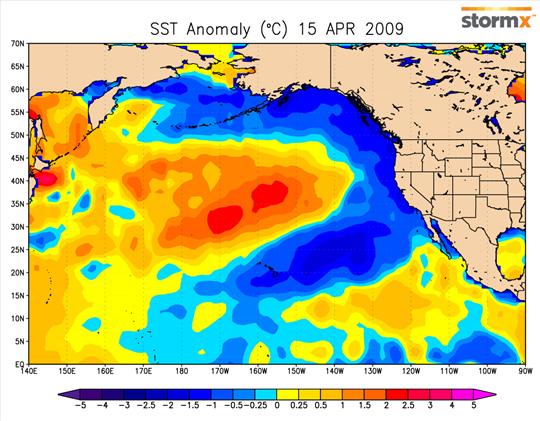
© StormX
The average PDO index from April 2008 to March 2009 was -1.46, the third lowest yearly averaged March value since 1900, trailing only March of 1956 and 1951. For the next two or three decades, North Pacific SST anomalies will favor the negative phase, and will likely produce exceptional climate patterns and weather events that have not been observed in more than three decades.
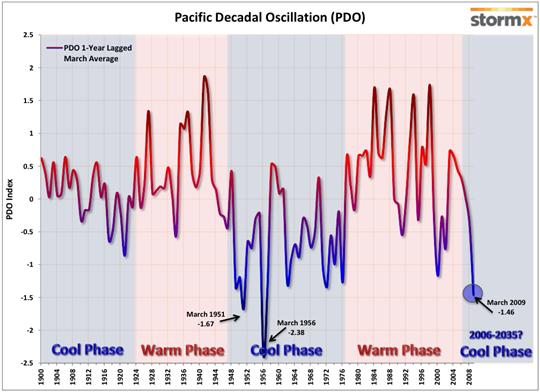
© StormX
The strongly negative PDO was influential in shaping North American climate during the past year. In 2008, Anchorage, Alaska, recorded only 2 days above 70 degrees F, the least number of days to exceed 70 since records began in 1917. The PDO strongly influenced the winter of 2008/2009 with dry conditions and warmth in the south central U.S. and snowy and colder than average temperatures in the Northern Plains. Although the PDO will continue to be the dominant climate driver for the remainder of 2009, its impacts will subside during the summer when the atmospheric flow weakens and climate is more strongly affected by local influences such as land conditions and proximity to water bodies.
The Storm Exchange science team has been quantitatively researching the climatic impacts of the cool and warm phases of the PDO. The University of Washington monthly PDO index begins in 1900, and by examining months in which the index is greater than 1 or less than -1, the PDO's impacts on climate can be contrasted. Using historical global weather observation analyses since 1948, Storm Exchange compared surface temperatures and precipitation during the cool and warm phases of the PDO from January 1948 to March 2009. During the cool phase (PDO < -1) annual temperatures in North America are more likely to be cooler than average from the Northern Plains to the west coast and northward into Alaska and the western territories of Canada. Warmer than average temperatures typically prevail in the southern and eastern U.S. and eastern Canada. During the warm phase (PDO>1) the pattern is reversed with southeastern North America becoming cool and northwestern North America experiencing warmer than normal temperatures.
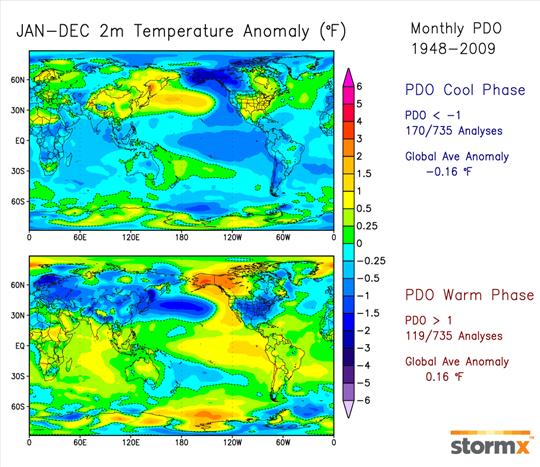
© StormX
A similar quantitative analysis was constructed for precipitation, revealing that during the cool phase (PDO<-1) annual precipitation is more likely to be below average from California eastward to Texas, Oklahoma, and Kansas. More abundant precipitation was found in central Canada and in the Northern Plains. A priori knowledge of this information proved invaluable this past winter, as most of these temperature and precipitation scenarios were realized in North America during the winter of 2008/2009. The PDOs historical impacts were an essential element of the Storm Exchange World Climate Service seasonal outlooks.
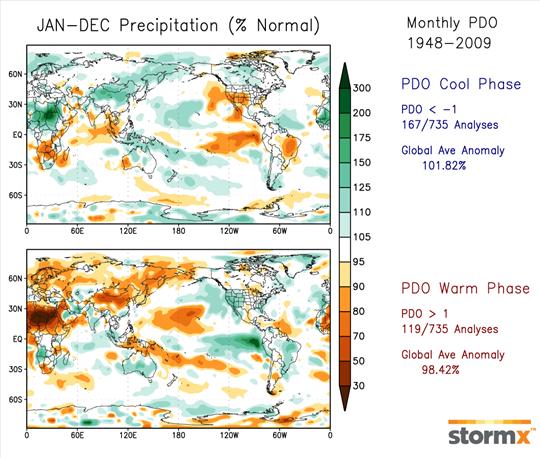
© StormX
The PDO is also found to be a global driver of temperature, partly because of its intimate link to the El Niño Southern Oscillation cycle. La Niña is more likely during periods of negative PDO, while periods of positive PDO yield more frequent and intense El Niño's. Thus the tropical temperature anomalies are highly correlated with the PDO phase and in turn help produce quantifiable fluctuations in global average temperatures. From the warm to the cool PDO phase, global temperatures drop by around 0.3-0.35°F. Some may contend that these observed global temperature differences are explained by the global warming trend, as the PDO cool phase was centered in the 1950s and the PDO warm phase in the 1990s. However, it remains plausible and perhaps likely that the PDO may be an important cause of the global change and observed temperature trends during the latter half of the 20th century. Scientifically, an improved understanding of global climate change may be on the horizon, as another cool PDO phase has begun and its impacts on climate will be studied closely. If global warming ceases or cooling occurs during the next 20 years, the scientific community may come to realize that decadal fluctuations within the oceans may play a larger role in climate than is presently acknowledged. The first signs of the PDO's impacts may already be occurring as satellite measurements of lower tropospheric temperatures derived by the University of Alabama in Huntsville (UAH) and Remote Sensing System (RSS) show no temperature increases since 2002, and in fact show a slight cooling trend. With solar activity at a
100 year minimum and the PDO expected to remain negative for several decades, the cooling trend may persist. If it does, an inconvenient truth about climate change may emerge.
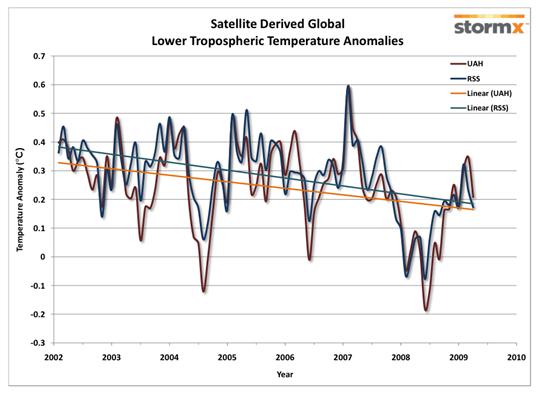
© StormX
Reader Comments
to our Newsletter